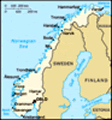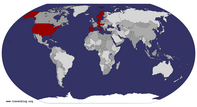Advertisement
This is our last day in Oslo, and the last day of our tour. Fortunately, our final city tour begins at 9:00AM so it gave us time to sleep in, and we were both awake before the alarm went off at 7:30. After heading down to a delicious breakfast, we were ready at the bus at 9:00 to meet our local guide Christina who was great at letting us know all about her native city, Oslo. Oslo is the largest city in Norway at about 700,000 people with a total of 1.1 million people in the greater Oslo area. The city was founded in the 11
thcentury, mostly as a trading center, but most of the original buildings were built from wood.
After several major fires that burned the entire city to the ground, in the 17
th century, after a particularly destructive fire, they finally decided to lay out all new, wider roads on a grid and mandate that all buildings be made of brick or stone. Since then the city continues to expand, and many of the older buildings have been replaced. While there are some remnants of the old 17
th century fortress, and there are some beautiful 18
th and
19
th century buildings remaining, most of Oslo is modern, with lots of activities, museums, parks, and restaurants. We visited Aker Brygge, the latest upscale apartments and shopping on the shores of the Oslo fjord. On a Saturday afternoon, it was teeming with activity from the locals.
The next stop on our city tour was Vigeland Park. Technically it is called Frogner Park by the people of Oslo, after the name of the original owner of the park itself. Tourists call it Vigeland park because of the statues sculpted by Gustav Vigeland which is also called the Vigeland installation. Originally commissioned by the city council in the early 1920’s, Vigeland was supposed to build a fountain in the center of the park. But Vigeland had a vision for a theme of “the circle of life” and wanted instead to build a sculpture park. Through funding by both public and private funds, the Vigeland installation consists of the original fountain in the center of the park and a series of 212 sculptures of ether bronze or granite surrounding the fountain on all sides.
The sculptures themselves are all nudes, with people engaged in various family activities. The figures are all
active and the faces of the subjects are very expressive. The sculptures are arranged beginning with statues of babies, working their way clockwise around the fountain through childhood, adulthood, into old age, and death, with the babies rising out of the bones of the dead and restarting the cycle of life. Vigeland said that the reason he made all the sculptures nude, other than sculptors like to sculpt nudes, is that if he put the subjects in clothing, it would date the subjects to the period by what they wore. By making them nude, the sculpture would be timeless. Since Jody is a sculptor herself, she was even more impressed by the technical skill of the artist. Neither of us had ever seen an installation quite like this one.
This concluded our city tour, though most of us continued on to the optional tour of the Fram Museum of Arctic Exploration. Christina explained to us what we would be seeing in the museum, along with some recommendations of things not to miss. We started with a 15 minute film on the exploration of the North and South Poles and the Northwest Passage in the late 19
th and early 20
th centuries. The first ship was the Fram, which means Forward in Norwegian, was designed and built by a Scottish-Norwegian shipbuilder named Colin Archer, but the specifications were developed by a then 24 year old Fridtjof Nansen who investigated the wrecks of previous Nort pole explorers and figured out that a ship built with a typical V-shaped hull would be caught up in the ice and crushed. He theorized that a more rounded hull would be able to rise up on the ice as it froze and would not be crushed.
The idea at the time was that once the boat was up on the ice, you would just stay on the boat for a couple of years, as the ice drifted over the north pole. Well, his theory of the boat hull was correct, and the Flam made it up onto the ice, but only drifted near the North Pole and never made it close enough to reach. A few years later, a second attempt was also unsuccessful.
In 1911, another Norwegian explorer, Roald Admundsen borrowed the Fram from Nansen to try for a third attempt at the North Pole, but by the time he reached Spain, he
told the crew that the plan was actually to reach the South Pole. So he set sail for the Bay of Whales in Antarctica and using a team of sled dogs, crossed the land and set the flag of Norway at the South Pole. By the 1920’s, the airplane had been invented and Admundsen decided that the best way to reach the north pole would be by air. Admundsen flew from Norway in 1926 and is credited as the first to consistently and verifiably reach the North Pole
The actual ship, the Flam that Nansen used in his North Pole attempts, and that Admundsen used in his successful South Poe attempt is in the Fram Museum since 1936. We were actually able to climb on board the Fram and visit below decks to see what life was like for these explorers. It was amazing that this is not a replica of the Fram, but the actual ship, the Fram that made these famous journeys.
Also in the Fram Museum since 2017 is the Gjoa, which was the first ship to travel through the Northwest Passage. Also piloted by Admundsen in 1905, the Gjoa reached Alaska through the Nothwest
Passage and on to San Francisco by 1906. Rather than sail the Gjoa back to Norway, Admundsen was convinced by the Norwegian community in San Francisco to sell it to them to display. It remained in San Francisco until 1972, when it was returned to Norway for restoration. Christina had recommended to us that we not bother to get on deck of the Gjoa as it was considerably smaller and much more difficult to go below decks. Jody and I decide to ignore her advice and went below decks anyway, and she was right, it was difficult, but we managed to persevere.
After leaving the Fram Museum, with a couple of t-shirts, of course, we headed over to the Maritime Museum gift shop and found some jewelry that Jody liked. We didn’t have time to visit, but we figured we may as well check out the gift shop. We also checked out the Kon-Tiki Museum gift shop, mostly because Christina told us that we could peek inside the museum from the gift shop and actually see the Kon-Tiki, the raft that Thor Heyerdahl used to cross from South America to Polynesia. I read the book as a child, and
it was great to see the actual raft.
By now Arpi was waiting for us with the bus and it was time to head back to the hotel. We had the afternoon free, and had to decide what to do. We really wanted to visit the Viking Museum and see an actual Viking Longboat, but it was recently closed for expansion and renovation and is not expected to reopen for about 5 years. In the end, we decided to go to the National Museum of Norway. One of the most famous paintings from Norway is The Scream by Edvard Munch. Now, there is a Munch Museum in Oslo, that contains most of his work, but his most famous painting, The Scream, is actually in the National Museum.
The National Museum was actually a very short walk from our hotel, so we made to the National Museum by 2:00. It closes at 5:00, and our farewell dinner is at 5:45, so this should give us plenty of time. Thera are only 2 floors with 87 rooms of exhibits. Fortunately, the rooms are well laid out in true Scandinavian fashion, and we were able to finish up viewing all the
exhibits by 4:30.
The museum was great! There were all sorts of Scandinavian artists that we had never heard of, but the artworks was good. We were able to see a few of the famous artists like Van Goth, Manet, Monet, Degas, and Rhoden. But there was also a room full of Munch, including The Scream, and even some more examples of Vigeland, other than what we had seen in the park this morning. We were able to take all the pictures we wanted, and we took a few hundred. But this is not an art blog, so I will post a few example pieces of artwork and leave it at that.
By the time we returned to the hotel, it was getting time to head out to our farewell dinner. The restaurant Maja chose was awesome, it looked like a library with books on all the walls. The food was delicious – we will both miss the delicious fish we have had here in Norway. Our trip to Scandinavia far exceeded anything we had expected. Our previous two European trips were mostly historical and this trip was mostly about nature. All of Scandinavia is amazingly beautiful, but
the fjords of Norway have to be the most beautiful place on earth. The people on this tour were awesome as well, definitely the friendliest bunch so far. Maybe it’s because there were more Canadians and less Americans. We will always remember Dot & Rob from Australia, Ray & Sheren from New Zealand, Gyles & Carol from Minnesota, and Cindy & Jeff and Anita from Canada.
This is our third tour with Insight Vacations, and our tour guide, Maja and our driver, Arpi were outstanding. We will be travelling with Insight again next year, the only thing to decide is where to go next! I owe my love of travelling to my mother, who visited some 33% of the countries of the world in her travels. We have a ways to go to catch up with her, but as long as we’re healthy, we’re ready to try!
Retirement is awesome!
Advertisement
Tot: 0.069s; Tpl: 0.014s; cc: 6; qc: 24; dbt: 0.0279s; 1; m:domysql w:travelblog (10.17.0.13); sld: 1;
; mem: 1.1mb




















